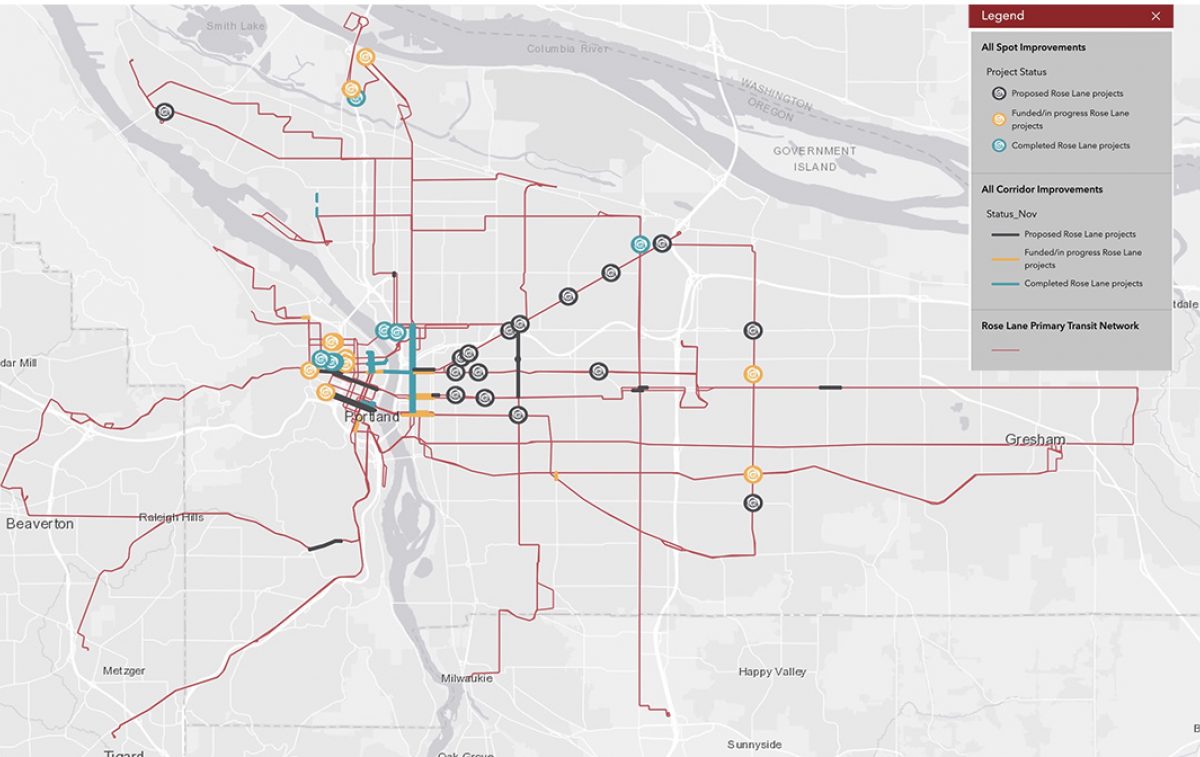
Undeterred by a steep drop in transit use during the pandemic, the Portland Bureau of Transportation launched an online open house and survey for the Rose Lane Project on Thursday.
With the open house comes the release of 25 new project proposals — that’s in addition to the 18 projects already funded or in progress and the 16 that have been completed since the initiative launched in 2019. The aim of all these projects is to make transit faster and more reliable, especially for Portlanders of color and those with lower incomes. According to staff from Commissioner Chloe Eudaly’s office, the Rose Lane Project is, “an effort to redistribute our right-of-way with a priority around racial equity, climate justice, and direct community benefits.”
Transit trip times have slowed in Portland in the past decade as our streets have become overrun with single-occupancy vehicle users. The number of drivers on our roads have risen sharply since 2010 and transit, biking, and walking rates have flatlined and/or decreased.
Advertisement
Armed with confidence from data that shows getting car users out of the way of bus operators speeds up service, PBOT is making it clear that transit-priority lanes, traffic signal updates, and other measures are a key agency priority.
Among the today’s releases are an interactive Rose Lane project map and in-depth fact sheets on eight TriMet bus lines. PBOT offers details on each proposal, including how the lines might/might not impact bicycling. In places where no existing bikeways are in place, PBOT has launched a research project with Oregon State University to understand how to manage bus and bike operators in the same lane.
Take a look at the online open house and project fact sheets, then take the survey. PBOT needs to hear from bicycle riders so we can help these projects reach their full potential.
— Jonathan Maus: (503) 706-8804, @jonathan_maus on Twitter and jonathan@bikeportland.org
— Get our headlines delivered to your inbox.
— Support this independent community media outlet with a one-time contribution or monthly subscription.

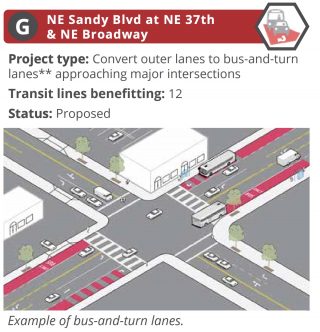
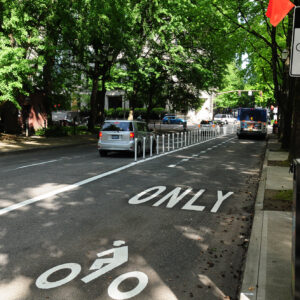

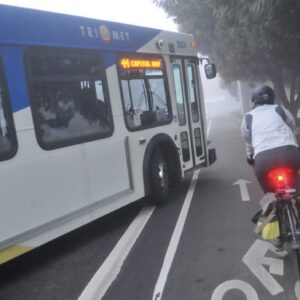

In the case of NY, bus lanes on 34th and 14th streets, for example, were faced with quite a few lawsuits as well as community board criticism, often under distress concerning the potential of cars diverted to neighboring streets. In its rollout of these bus lanes, the DOT designed parallel PBLs, which were equally distressing to CBs. By and large the increased traffic did not materialize. Bike modal share continued to increase. Bus commute times were significantly reduced. So well done on their part. My worry with PBOT is they often appear to believe that neighborhood greenways are adequate infrastructure for people on bikes, when in reality, they are auxiliary at best. In their proposal to build rose lanes, they will have cemented car-centric design for multiple commercial corridors (ie Sandy, Hawthorne, E Bway), leaving no space for PBLs and maintaining unsafe conditions for pedestrians. Theoretically, I am in support of bus only lanes. I worry PBoT may be conveniently tying its own hands through painting Rose lanes to prevent any further development of a functional PBL network, further stagnating bike modal share for decades.
I’m skeptical (ok, scared) of lanes shared by people on bikes and 40,000-pound buses. The physics aren’t good.
What, professional drivers like big rig jockeys? Big rigs have never been a concern for cyclists.. ever… at all.
TriMet does not require a CDL. So, bus drivers don’t even have the same professional training a rig jockey has.
https://trimet.org/careers/part-time-bus-operator.htm
Buses drive like cars, so they are like giant SUVs. Bus drivers come from all walks of life – just like regular motorists and have the same variety of biases. TriMet inculcates their drivers with a combination of strict discipline and entitlement.
I used to work in Harrison Square building, where TriMet occupies several floors. They would, very regularly, stomp on the reservation that my company made for the conference room, in order to carry out disciplinary meetings.
I once had occasion to complain to the TriMet dispatch (via email) that I was nearly run over because a bus didn’t yield to my right of way. I was told, by the Assistant Manager of Transportation at TriMet that buses don’t yield to anyone.
And if anyone wants to look up Bud Worthey, I can’t find a source at the moment. He is the driver that gave a cyclist a punishment pass on Sandy to “teach him a lesson”. Bud is a Harley rider in his personal time. At the time of the incident, he had been a TriMet driver for only a few years. So, 1) they don’t weed out biased drivers, 2) they don’t identify bad characteristics and train them away, or 3) they encourage drivers to be aggressive.
That being said, some bus drivers are really great people. But the bus is as unpredictable as a regular car. Only, much larger.
TriMet does not require a CDL?
TriMet: You do not need a CDL. We’ll provide training and testing. (6 weeks+) However, you must pass the CDL written test before starting employment with TriMet.
If anyone -ever- has a problem with an Operator- Call 238-RIDE (238-7433) and file a complaint.
My mistake, I didn’t read my source well enough.
However, I lodged my complaint with customerservice@TriMet.org. I have the email transcript where I exchanged emails with the Assistant Manager of Transportation. Granted, your phone line might be a more effective method of changing behavior. However, I think it is very telling to be brushed off by the Asst Mgr of Transportation.
TriMet DOES require a CDL. The link you provided clearly states “Commercial Driver’s License (CDL) – You do not need a CDL. We’ll provide training and testing. However, you must pass the CDL written test before starting employment with TriMet.”
My mistake, I didn’t read my source well enough.
What are your thoughts on my other observations though?
with 6-8 buses an hour at peak, there isn’t a lot of sharing that needs to happen.
Great point. The fact is, most bus lines are not that frequent and most of the time a bus/bike lane will be awesome, just a super-wide bike lane.
I think what you Momo and Allan might be overlooking is that it’s not enough for something to actually be safe and OK to ride in. It must look and feel safe and OK to ride in. What you are sharing here is the same vibe that in my opinion has contributed to the lack of growth in cycling mode share for many years. That is, experienced riders who forget how scary this thing we do is to folks who 1) don’t bike yet and 2) are new to biking.
This is what I feel happened downtown forever: Folks like Roger Geller at PBOT who felt like the fact that we had signals timed for “bike speeds” of 10-12 mph was OK for cycling. I realize Roger knows we need better bikeways downtown, but my point is that because this technical thing (signal timing) made streets relatively safe and it felt fine for experienced riders, it took away a lot of the urgency from Roger and other folks at PBOT to make the type of substantive changes we need (like the protected bike lanes that are only now, very slowly and cautiously) being rolled out.
I agree that the “Bus Lane” on MLK/Grand and the ones coming on Sandy are nice to have and I will use them, but they are absolutely not the type of real bike infrastructure we desperately need and the “interested but concerned” won’t get anywhere near them. I’m very hopeful that we will see major biking improvements through the Rose Lane Project but I’m a bit concerned that it’s so transit centric despite all the years of advocacy for cycling and demands for space on these very important major streets.
During lower traffic periods, these bus/bike lanes are going to be fantastic for strong/confident riders. They will become quite dangerous when traffic picks up, though. Cars will be stacked up in the left lane, and right hook and left crosses will be a major issue. I would love to blast down Sandy past a line of cars stuck in traffic during rush hour, but it’s going to be scary.
There’s no right hook risk, because right-turning cars also use the bus/bike lane to turn right.
Yeah, I agree. Although I enjoy and use a lot of the unprotected bike lanes around town my wife and kids do not. I can’t really get them to bike longer distances in Portland due to this fact.
Same. I have an 11 year old and his friend lives .8 of a mile away from my new house, using the 52nd bike lane for 90% of the ride. I’ll probably teach him to ride over there using a combination of less busy streets, sidewalks and the Franklin High school cut-through. And he is a good rider.
The physics are better if buses and bikes are sharing a lane than if they were side by side, no? If a bike lane is to the right of a bus lane they can get side-swiped or right-hooked due to poor visibility. Sharing a single lane means bikes and buses are single file. Bus drivers are pretty careful drivers, I don’t think they are likely to run straight into a bike rider in front of them.
Protected intersections offer the line of sight you’re looking for.
I agree with most of the article, but that graph in the article is horribly misleading, to the point of being a detriment to public discourse. In particular, the y-axis is change in the number of commuters, not absolute numbers. This is poor form from whoever created this visualization because the number of bike, transit, and walking commuters has increased every year, while a quick glance at the graph would lead you to think that’s they’ve been flat or actually decreasing.
In addition, by framing it as absolute change rather than percent change in the number of commuters using each mode, the graph has no context for whether more a higher percentage people than before are using active transportation modes rather than motor vehicles. Frankly, whoever created that graph almost certainly did so with the intent to mislead.
If I were in your position, I would remove the graph from this article immediately, as it is not a faithful representation of the data.
thanks for the feedback. I’ve taken it down for now and edited the sentence about it. I’ll take a closer look tomorrow.
Thanks for being willing to take feedback on board!
“the number of bike, transit, and walking commuters has increased every year”
This is not correct. The absolute number of bike and transit commuters has markedly decreased since their peaks in 2014 and 2012 respectively. Moreover, the absolute numbers of transit boarding riders has decreased 5 years in a row.
https://trimet.org/about/pdf/trimetridership.pdf
(Portland population has increased around 8% since 2014 so these decreases are unprecedented.)
Interesting. Not what the graph that was originally in the article showed.
It looks like ridership hit a peak in 2009 then dropped off a bit, then hit another peak in 2015 and has been dropping again. The 2009 peak was the Great Recession followed by cuts in TriMet services and the end of Fareless Square. Not sure why there was a peak in 2015.
The open house lists 9 projects, 3 of which have projected peak-hour end-to-end time savings of over 5 minutes. The other 6 promise to save less. Given that no one rides end-to-end we’re talking about some pretty modest improvements.
This isn’t going revolutionize transit it in Portland. I doubt most riders will even notice.
Seriously! Meanwhile, protected bike lanes + e-bike would get you from 7th/Sandy to 82nd/Sandy in literally *less than 15 minutes* every single time, any time of day, any day of the year. It literally doesn’t get any better than that, and yet PBOT is still treating cycling infrastructure as if it’s only for some kind of niche special interest group, and not the most affordable, equitable, and potentially fastest transportation mode there is. I would expect this from the Virginia DOT, but from an agency with as many progressive staff as PBOT, frankly, it’s disgusting.
Cute little bike lanes don’t make much money for local construction companies, over the top auto-cargo-centric construction does.
Peak hour end to end time is not the only thing that matters. Reliability matters too (and a very late bus, say, once a week, actively discourages ridership). These proposed changes won’t revolutionize transit, but I still think they are good steps.
Agreed; I didn’t see any published analysis of reliability, so I’m not sure that TriMet/PBOT sees that as a measurable benefit of these projects.
To be clear, I’m not saying these projects are a bad idea. I am, however, saying that PBOT is wringing a lot of mileage around some very minor system improvements, rather than making changes that would actually result in… change.
It’s not the projects that rankle, it’s the loud horn tooting and endless polishing of what amounts to a participation trophy.
I agree; I think the very use of the phrase “Rose Lane” to refer to mostly signal priority projects 1-2 blocks in length is misleading PR-speak. Any normal person who hears the phrase “Rose Lane” in the context of transit is going to think of a substantial length of “Rose Lane” for buses.
Honestly, the best that can be hoped for is that these projects tread water against the increase in bus travel times in Portland due to increased traffic. It’s worthwhile and I’m glad they’re doing it, but it’s also disappointing compared to the need that’s out there.
I think this is the appropriate response. Transit agencies should constantly be working to improve these little details, and they deserve some kudos for doing it. But yeah…nothing groundbreaking. Hopefully this will turn into an ongoing project. If PBOT could roll out improvements similar to this year after year, that would start to make an impact.
Kitty, you need to come out to SW Capitol Hwy in SW Portland during a typical evening rush-hour (pre- or post-pandemic). There you will see long lines of cars and buses crawling up the hill toward Sunset. Hundreds of people in buses wait as drivers of single-occupancy vehicles take up the limited road space. Buses all must stop just before Sunset, so they wait in the right lane for cars to clear, and when the buses stop, the cars behind them also have to stop and wait. It’s a mess, and it’s crying out for a solution.
You might be right about some parts of Portland, but you don’t know all of Portland. There are places in Portland, like the stretch of SW Capitol Hwy between Terwilliger and Sunset, where the dedicated bus lanes will be a game-changer for transit users.
I was just repeating TriMet’s rather modest claims, not relying on my personal knowledge. Follow the link to the open house above, and behold the time savings for the 54/56 bus, projected to save 1-2 minutes end to end during the p.m. rush hour. I don’t know if that’s the same project you are referring to, but it’s the only one I saw in SW.
What will you do with all that time?
Those are average travel time savings. Surely on some days or at the peak of the peak the savings will be much higher, just as some days the savings will be lower. More reliability is key. But it’s probably harder to model or explain than average travel time savings.
Nothing turns regular riders away more than extreme delays and reliability issues. The fact is, before the pandemic, many of the busiest bus routes would suffer from bus stacking and delays easily exceeding 20 minutes during rush hour. If public transit is frequent and reliable, you can build ridership.
Please tell that to TriMet who is re-routing their marquee #2 kneeling diesel BRT bus so that it crosses the UPRR mainline tracks at SE 8th & Division. Anyone who knows that area knows it will result in extreme delays and reliability issues.
TriMet’s own data shows that the crossing is currently blocked more than 11% of the time. Given UPRR’s plans to increase use of those tracks, I expect the situation will degrade in the future.
If the average changes by two minutes but the peak times improve by 10, why wouldn’t Trimet be trumpeting all over the 10-min peak reduction? The bang for the effort here sounds pretty disappointing.
(edit: moderated again. Is it because I used “bang”?)
The trumpeted times are PM peak hour improvements.
That’s like saying that building out our bike network incrementally is pointless because most individual projects are hard to notice. We build bike lanes all the time that don’t connect to anything in the near term, nobody notices, but then it becomes super useful later on. It’s okay to make incremental improvements that all added together over time make a big difference. This isn’t a Bus Rapid Transit Plan. It’s a plan for a series of modest improvements to keep transit from getting quite so stuck in traffic. A Bus Rapid Transit Plan would be awesome, but that would probably need to be led by TriMet and/or Metro. PBOT is trying to do things they can control that don’t cost a lot of money.
As I wrote above, I have nothing against these projects. It’s the parade that PBOT is throwing itself for adding a turn restriction here and a shared lane there that is stuck in my craw.
I welcome modest improvements, but they deserve modest praise.
This is so awesome. I’m really looking forward to these projects.
And to think, I never had to ever think of myself as a “bus advocate” for any of it to happen.
For those who find Rose lanes to be just another extension of the bike network, please consider this recent death on a bus lane in Harlem today.
“According to the preliminary NYPD report, the driver of a truck hit and killed a 41-year-old man along First Avenue in East Harlem on Friday morning at around 8:30 a.m. — with cops saying the cyclist was going the wrong way before the crash near E. 118th Street. But police ignored a history of reckless driving and illegal parking connected with the truck in question that just as likely could have contributed to the man’s death.”
I don’t plan on riding the wrong way in these Rose Lanes, so this shouldn’t be an issue.
It’s not impossible this preliminary report is correct, but the NYPD is notorious for their car-centric bias. Here is yet another example of that.
Looking at the map, I thought “Oh finally some love for Chavez Blvd”. Looking at the detail however, it appears no changes planned at Coe Circle (where it intersects with Glissan).
Here is what is proposed up and down from the Circle: “Drivers on Cesar Chavez approaching the Glisan traffic circle in the outside lanes already have to turn right onto Glisan, while buses can use the outside lanes to travel through the intersection. The proposed project would extend this traffic pattern further north and south, making the outside lanes “right turn except bus” at every intersection.”
At first glance it would seems like a no brainer since the lane becomes right turn only at the Circle anyway. But the circle is such a bottleneck that that right lane (in particular going north passed the burnside intersection) serves as a buffer, allowing cars to merge and filter through the circle while the light is red at Burnside. With its current design, it already seems to barely be able to keep up with the light at Burnside, so although I don’t have the data to prove it, it seems Coe Circle is on average actually slower than if we had a traffic light there. So if they are not going to make this into a proper yield circle, why not simply put a light there as well so as to at least keep up with the traffic crossing Burnside.
All in all, that whole Chavez corridor south of there from Holgate to Stark is really a sorry sight with tiny substandard sidewalks and no buffer from traffic since there is no parking lane, but that section is not part of this project.
On the plus side, if you were to ride the entire length of the 75 bus, this project will save you up to one minute during the PM peak, according to PBOT.
6 years ago when I attended the founding BikeLoudPDX meeting, I would never have thought that “vehicular cycling” would become the dominant ideology in Portland’s cycling advocacy spaces.
And, yet, here we are at 5.1% mode share — a 28% decrease in just 6 years.
(Average PBOT bike counts show a similar but larger decrease so don’t @ me about “commuters” or “census methodology”.)
Soren, I am also markedly flabbergasted at the weird vehicular cycling dogma of Portland cycling advocates. I have no real explanation. But there is hope. NY seems to have turned the corner and vehicular cycling appears to be a lot less supported there than even 5 years ago. You’re not alone in wanting protected bike lanes. It’ll happen here. Just takes a lot more injuries and death.
I think one of the key differences is that in NYC rent control, rent stabilization, and public housing preserve demographics that are not well off. This allows pockets of empathetic politics to persist. Portland, on the other hand, is headed towards a future where the city proper is dominated by wealthy people and surrounded by suburbs and exurban areas where lower-income people struggle to survive. I personally see no path to changing this dynamic in Portland.
It’s possible, although NY has orders of magnitude more public housing. Transalt is very effective at coordinating advocates and getting media exposure. The MTA is also pretty decent compared to Tri-Met. PBL mileage is now one of the measures that the advocacy groups and the DOT use to gauge progress. I’m not convinced Portland is “dominated by wealthy people” as evidenced by the current income map. There is a perception of Portland, both internal and external, that is often at odds with what is suggested by research.
I did not say it was dominated by wealthy people now (although politically it always has been) but rather that it is “headed towards a future” where it will be demographically and politically dominated by wealthy people.
Median Household income of a owner household (2017): $87,249
Median household income of renter household (2017): $39,998
Median household income of black renter household (2017): $19,189
2017 income histogram (note 2019 is worse):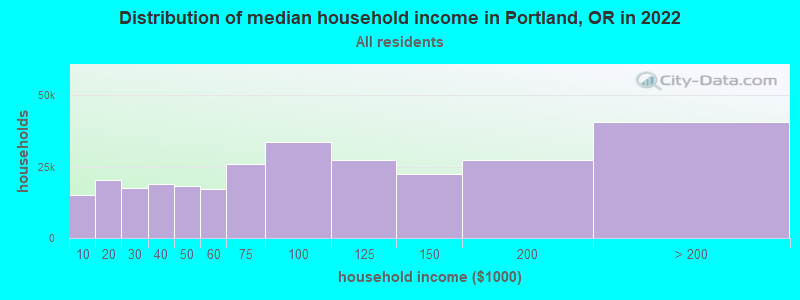
In Portland, virtually all population growth is in the upper-income demographic while the lower-income demographic is being rapidly displaced outside of Portland (and Oregon). Recent zoning reforms are so ridiculously anemic and single-family-centric (e.g. RIP) that I expect this trend to accelerate.
Note: income growth in the upper income tranches has vastly outstripped inflation while income growth for renters has decreased in real terms and decreased in nominal terms for black renters.
Nice info. In general a lot of cities all over the country are experiencing very similar changes in demographic income distribution. This is well over my knowledge. Maccoinnich might be able to provide more in depth info.
“a lot of cities all over the country”
Of course. Portland and the USA’s socioeconomic system is based on the every increasing concentration of housing capital income by a few.
@maccoinnich and I agree on essentially nothing when it comes to housing justice, the need for market housing, or even mild regulation of predatory landlordism.
I’ve done my share of griping about bike lanes here but anybody who has seen me tactically riding on the sidewalk would know that I am far from dogmatic. If there are any VC left in this town that will bring them out of the shrubbery. VC has its place but I’d be damned before I rode with a (borrowed) kid across the deck of the St. Johns Bridge, for instance. I’m a pragmatist.
Portland is actually kind of a soft town to ride a bike in. If you doubt me go spend half a day biking in Philadelphia, or Sonoma County for that matter, and come back and kiss the ground. However our bike infrastructure is a real mixed bag. PBOT throws something down, or up, and if it works I ride on it. If it doesn’t work, back to plan B. I’ve never lived in a place with serious bikeways.
If I’m in an actual hurry that motivates a bit more VC and arterial riding. Portland relies on greenways for a lot of its bike network and for me the greenway experience is very much like poking along through the side streets, a thing that was always a choice. On a grid all routes are more or less equivalent once you learn the cemeteries and overpasses. Yes there are places where the terrain breaks the grid, and those places are where a little infrastructure would be nice.
Yeah X Pland has a lot of residential streets, so you can zigzag all day and stay somewhat safe (compared to philly or NY). It’s just not practical to get around that way.